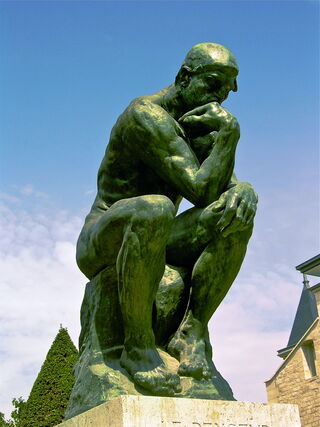Memory
What Actually Is a Thought? And How Is Information Physical?
Thoughts are physical representations or maps. They have shape and weight.
Updated October 7, 2023 Reviewed by Ekua Hagan

Google the word “thought” and you will find this uninformative, circular definition: “an idea or opinion produced by thinking, or occurring suddenly in the mind.” The Merriam-Webster dictionary defines “think” in a similarly unhelpful way: “to form or have in the mind.” But what actually is a thought?
A thought is a representation of something. A representation is a likeness—a thing that depicts another thing by having characteristics that correspond to that other thing. For example, a picture, image, imprint, or mold of an object is a representation of that object.
A map is another example of a representation. The mind is a kind of map. The brain, and its functional product the mind, evolved as a map of the body’s relation to its external environment. Fundamentally, our thoughts are maps representing and corresponding to things that our brains have either perceived with our senses, felt with our emotions, or formed as an action plan (e.g. forming an image of reaching for a ripe fruit on a tree branch). All of these are electrochemically mediated processes. Thoughts may be fleeting, or they may later be consolidated as memories. Memory too is a physical process, encoded by structural molecular changes in neuronal connections.
Sensory perceptions and their memories are physical representations or maps, imprinted by an event
Let’s consider how sensory perceptions are transduced by the sense organs into neural signals:1
Imagine hearing a clap of thunder that surprises and frightens you. The sound of the thunderclap is transformed from a specific pattern of sound waves in the air, to a corresponding pattern of vibrations transmitted through your eardrum and the small bones in your middle ear to your cochlea, to a corresponding pattern of electrochemical impulses along the auditory nerve, to corresponding signals in neurons in the auditory cortex and association cortex. It also activates fear circuitry, relayed via the amygdala, and perhaps also visual circuitry that records what you saw at that moment. Signals are transmitted between neurons by chemical neurotransmitters. The entire widely distributed network activated throughout the cerebral cortex by this stimulus is the experience at that moment.
Since this was such a strong stimulus—a "flashbulb memory" moment, the pattern of connections in this particular network is then made permanently retrievable. This happens by changes in membrane proteins at the connections between all the participating neurons that fired together in response to that stimulus—“Neurons that fire together wire together” (Hebb's Law).
This constitutes the memory: The same approximate network can be reactivated in the future by a reminder, some association cue. The pattern of connections is a representation (a "map") corresponding to the pattern of information that you perceived. It is likely also interwoven with representations of other feelings or memories that you associate with that experience, adding layers of meaning to the experience.
Information is physical
Modern information theory has taught us that information is a physical entity. Rolf Landauer, an IBM physicist, stated the case:
"Information is not an abstract entity but exists only through a physical representation, thus tying it to all the restrictions and possibilities of our real physical universe” “Information is inevitably inscribed in a physical medium."2
Elsewhere, Landauer explained further:
"Information is not a disembodied abstract entity; it is always tied to a physical representation. It is represented by engraving on a stone tablet, a spin, a charge [i.e. of elementary particles such as electrons], a hole in a punched card, a mark on paper, or some other equivalent."3
So too, no thought can occur without its neural substrate.
Information is relational
Information is the pattern of organization of matter or energy—the way things are arranged in relation to each other.
Consider computer code. Differences in voltage in the computer’s circuitry, conventionally represented by ones and zeros, represent different alphabet letters when associated with each other in particular patterns: The letter “A” is represented by 01000001 and the letter “B” is represented by 01000010. There is nothing inherently meaningful contained in a particular voltage in an isolated part of an electrical circuit. It is from the association or pattern that information emerges.
Likewise, there is nothing inherently meaningful in the arbitrary symbols that comprise the letters of an alphabet, or in the sounds of the individual words of a language. They assume meaning only in relation to each other, and in their pairing or association with real things in the world.
Complex information such as memory is distributed
Just like the letter “A” encoded in a computer circuit, your memory of your grandmother is not "contained" in one neuron — a "grandmother neuron," as opposed to, say, a "president of the United States" neuron. There is a vast network of (often distant) neurons that, in their connections with each other, collectively represent your grandmother memory.
One particular neuron might perhaps encode a tiny memory fragment of your grandmother, let’s say just one visual aspect of one particular facial contour. That is to say, that particular neuron will fire electrochemically when paired with visual input matching that contour. Nor is that one neuron dedicated solely to holding that piece of your grandmother memory; the same neuron probably participates in a great many other memories by virtue of its membership in a host of different connections with other arrays of neurons.
Furthermore, different aspects of each memory are associated with a multitude of other memories — aspects of your grandmother memory might be associated with your memory of a particular kind of apple pie. As noted earlier, the particular network of neurons that forms a particular memory is likely the same network that was activated during the initial perceptual experience of the remembered event. Most momentary perceptions are not permanently remembered. Only some are, becoming seared into long term memory by virtue of their salience at the time.
Abstract thoughts are fundamentally physical too
What about more abstract thoughts – how could those possibly be physical?
Thoughts of a more abstract nature are just higher-level representations. They are built from hierarchies or ladders of representations (i.e. representations of representations). One thing reminds us of another because of some similar feature. At the bottom are still the physical sense perceptions and movements, upon which all other thoughts are built. Abstract thoughts are in essence still fundamentally just "maps" corresponding to the external environment and the individual’s position in it.
A map is an analog of the environment it is depicting—it corresponds to it. An analog is something that is similar to, or comparable to, something else either in general or in some specific detail. Maps can be regarded as a form of analogy-making ("A" is to "B" as "X" is to "Y").
Cognitive scientist Douglas Hofstadter and psychologist Emmanuel Sander suggest that all thoughts are built from analogy-making. They propose that categorization through analogy-making is “the driving force behind all thought.”4 Our brains detect similarities or correspondences between newly and previously encountered situations, enabling the application of previously learned information to the new situation. “The very essence of an analogy is that it maps some mental structure onto another mental structure.”5
Language is replete with examples of the ways in which thought is built from analogy-making. Our words for things that don’t exist "out there" in nature are built from words that represent concrete things that we can perceive with our senses.
Here is a sampling of some of the simpler analogies/metaphors from Hofstadter and Sander’s elaborate collection: “the legs of a table; the spine of a book; . . . the tongue spoken by the islanders; . . . the window of opportunity for doing something; the field one studies; a marginal idea; salaries that fall within a certain bracket . . .”6
Similarly, our five major senses are recruited by our language to describe abstract phenomena in familiar physical terms. For example: “one can be touched by a kind gesture, struck by a beautiful scene, or hurt by a jabbing remark.” Or: “one can taste the joy of victory, find a movie to be tasteless, be in a sour mood, or make a bitter remark.”8 Happiness and unhappiness are represented in vertical space (to raise someone’s morale; to plunge into despair; to be very down). Abstract notions are often conveyed through comparisons to familiar human activities (her experiment gave birth to a new theory; the facts speak for themselves; . . . a religion dictates certain behaviors; his fatigue caught up with him.)”7
The conscious sense of self emerges from loops of self-referent symbolic representations
Elsewhere, Hofstadter explored the question of how through self-reference and formal rules, systems can acquire meaning despite being made of "meaningless" elements.9 And how the psychological self emerges from abstract feedback loops of self-referent symbolic representations, recursively reflecting on itself in a reverberating circuit—a cybernetic loop.10 Quite a dizzying concept.
The sense of self begins with the nervous system’s map of its own body
The neuroscientist Antonio Damasio proposed a model for how the self emerges in gradations, in organisms of increasing evolutionary complexity. According to this model, a simple organism develops a rudimentary form of "self-awareness" by forming a map of its body and its position in the physical space it occupies. Damasio calls the most basic representation of self the protoself—a nonconscious state that many species may have. It’s a very basic level of awareness comprised of neural patterns representing or mapping the body's physical structure.11
Mind reading based on thought shapes
Since thoughts are physical and have spatial dimensions (each thought being represented by complex connections between large arrays of neurons), you might wonder if it’s possible to "read" a person’s thoughts from their brain's patterns of neuronal activity. In fact, scientists have already been onto that project for several years: See this Psychology Today post and this article by Matthew Hutson.
Weighty thoughts
The brain requires an inordinate amount of energy to do its work, utilizing 20% of the body’s energy consumption at rest, despite accounting for only 2% of the body’s weight. The brain’s rate of caloric burning increases when engaged in cognitively demanding tasks. Energy and mass are interchangeable (E=mc2). Since thoughts are energy signals, the energy transmitting a thought therefore has mass. The ions and molecules encoding the energetic signal have mass too. But can we actually calculate the weight of a single thought? Certainly it would be an infinitesimally tiny number. But not zero. For one speculative stab at this question: see this PBS Nova video.
In summary: Information is physical and relational, and we are networks of information
Thoughts are not ethereal. They are representations of matter and are encoded in matter. They have shape and weight. Abstract ideas are analogically built from more concrete sensory representations. The sense of self is built from self-representations. Thoughts are forms of information, and all information is physical and relational. It "feels" like something to "have" a thought and to "be" a self because we are that information, recursively reflecting on itself in an infinite regress.11
References
1. Parts of this article were adapted from: Ralph Lewis, Finding Purpose in a Godless World: Why We Care Even If The Universe Doesn’t (Amherst, NY: Prometheus Books, 2018). The book is a deeper dive into questions of purpose, meaning and morality in a random, purposeless, godless universe. It provides an accessible understanding of the counter-intuitive scientific insights that have led today’s scientists to confidently state that the universe, life and human consciousness are the wondrous products of fundamentally random, unguided processes that have yielded the appearance of intelligent design.
See this YouTube video link for an engaging Power Point presentation in which Dr. Lewis explains how a family health crisis focused him on coming to terms with the outsized role of randomness in life, and to wrestle with the question of whether the scientific worldview of a fundamentally random universe is nihilistic. He summarizes how science has come to view the universe and absolutely everything in it as the product of entirely spontaneous, unguided processes, and why this is actually a highly motivating realization for humankind. Or see this link for a very brief video providing a synopsis of the book.
2. Landauer, R. “Information is a physical entity.” Physica A. 263, no. 1-4 (1999): 63-67.
3. Landauer, R. “The physical nature of information.” Physics Letters A. 217 (1996): 188-193.
[Click 'more' to view footnotes 4-11]
4. Hofstadter, Douglas R., and Emmanuel Sander. Surfaces and Essences: Analogy as the Fuel and Fire of Thinking. New York: Basic Books, 2013, p. 135. See also Pinker, Steven. The Stuff of Thought: Language as a Window into Human Nature. New York: Viking, 2007.
5. Surfaces and Essences, p. 50.
6. Surfaces and Essences, p. 62.
7. Surfaces and Essences, p. 63.
8 Surfaces and Essences, p. 287.
9. Hofstadter, Douglas R. Godel, Escher, Bach: An Eternal Golden Braid. New York: Basic Books, 1979.
10. Hofstadter, Douglas R. I Am a Strange Loop. New York: Basic Books, 2007. For a couple of other well developed theories (among several available) of how the conscious self emerges, see Tononi and Koch's Integrated information theory (IIT) (their speculations about panpsychism are much more tentative and controversial, and not central to their theory), and Michael Gazzaniga's modular mind theory.
11. Damasio, Antonio R. The Feeling of What Happens: Body and Emotion in the Making of Consciousness. New York: Harcourt Brace, 1999. Damasio suggests that the most basic building blocks of consciousness are the neural representations or mapping of the body in the brain, and all of the brain’s homeostatic (equilibrium) and regulating mechanisms for the body (e.g. regulation of blood pressure and breathing rate). The next levels of building blocks of consciousness emerge from the organism’s perception of other objects in its environment, and the organism’s instinctual responses to those objects. Instinctual emotions, originating as homeostatic mechanisms, play an important role in orienting and motivating higher animals’ responses to environment stimuli (Damasio, Antonio R. The Strange Order of Things: Life, Feeling, and the Making of the Cultures. New York: Pantheon Books, 2018).




